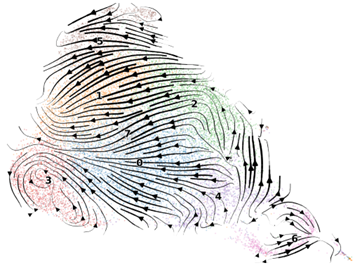Hi @trebbiano ,
1) Thx for mentioning the directionality of the model. Indeed sometimes the unified-time setting has this potential drawback that the given velocity is reversed. This might also occur in other models with a similar design in how cell-specific time points are generated (e.g. scTour). For now, we might not have an optimal way to determine this beforehand, however, we've provided an alternative, to run the model twice with the opposite initialization of parameters, if a reversed streamline field is observed. config.NUM_REP =2 might do the trick.
2) The error above might be related to an unfinished feature I tried to implement, which should be temporarily removed. Kindly try version==0.2.5.1 to see if it works.
Bests, Mingze
 For comparison, independent mode
For comparison, independent mode  Cluster 6 in this dataset comprises actively cycling cells.
I am interested in the relationship between clusters 6,4,0 and 3, and whether the
Cluster 6 in this dataset comprises actively cycling cells.
I am interested in the relationship between clusters 6,4,0 and 3, and whether the
Hi, I'm running UniTVelo and obtained some strange results with the default settings. Specifically, the velocity direction was inverted compared to scvelo and biologically feasible results. However, when I modify the default settings, the following error appears. Any ideas?
Parameter choices are as follows:
System and version information:
The full error message: